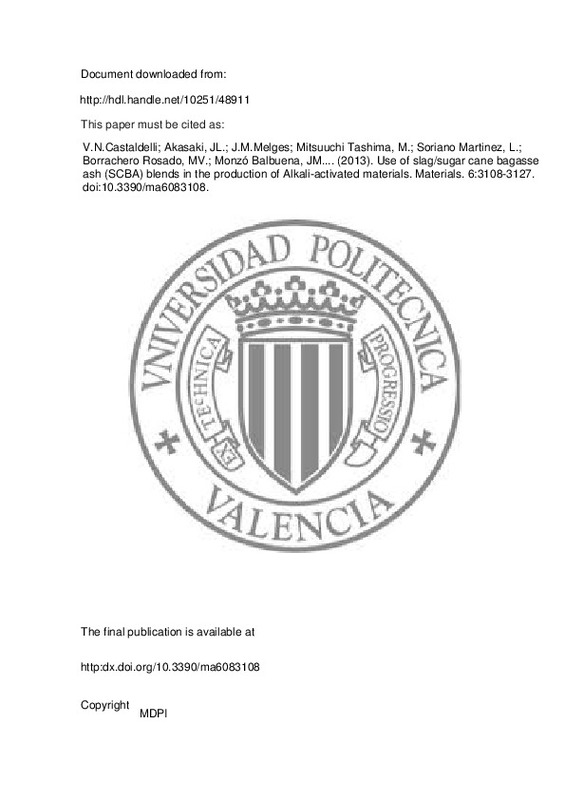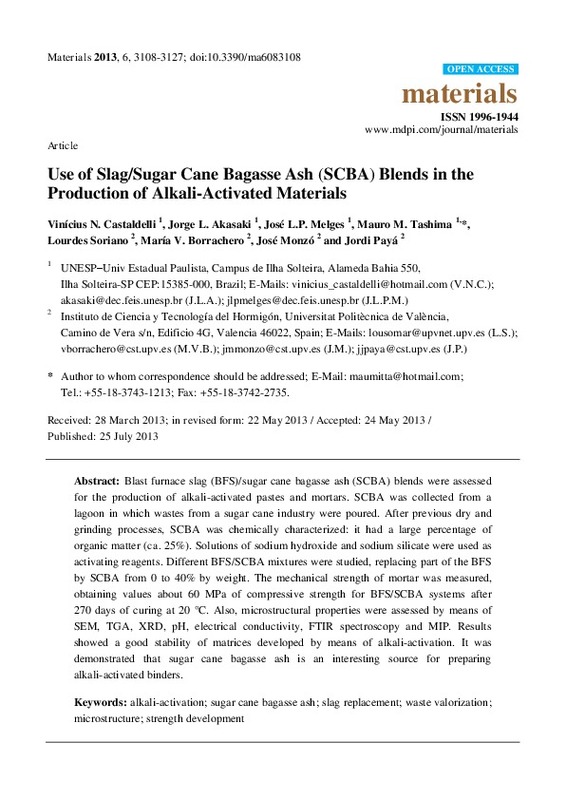JavaScript is disabled for your browser. Some features of this site may not work without it.
Buscar en RiuNet
Listar
Mi cuenta
Estadísticas
Ayuda RiuNet
Admin. UPV
Use of slag/sugar cane bagasse ash (SCBA) blends in the production of Alkali-activated materials
Mostrar el registro sencillo del ítem
Ficheros en el ítem
| dc.contributor.author | Castaldelli, V.N.
|
es_ES |
| dc.contributor.author | Akasaki, Jorge Luis
|
es_ES |
| dc.contributor.author | Melges, J.L.P.
|
es_ES |
| dc.contributor.author | Tashima, Mauro Mitsuuchi
|
es_ES |
| dc.contributor.author | Soriano Martínez, Lourdes
|
es_ES |
| dc.contributor.author | Borrachero Rosado, María Victoria
|
es_ES |
| dc.contributor.author | Monzó Balbuena, José Mª
|
es_ES |
| dc.contributor.author | Paya Bernabeu, Jorge Juan
|
es_ES |
| dc.date.accessioned | 2015-04-16T16:49:04Z | |
| dc.date.available | 2015-04-16T16:49:04Z | |
| dc.date.issued | 2013 | |
| dc.identifier.issn | 1996-1944 | |
| dc.identifier.uri | http://hdl.handle.net/10251/48911 | |
| dc.description.abstract | Blast furnace slag (BFS)/sugar cane bagasse ash (SCBA) blends were assessed for the production of alkali-activated pastes and mortars. SCBA was collected from a lagoon in which wastes from a sugar cane industry were poured. After previous dry and grinding processes, SCBA was chemically characterized: it had a large percentage of organic matter (ca. 25%). Solutions of sodium hydroxide and sodium silicate were used as activating reagents. Different BFS/SCBA mixtures were studied, replacing part of the BFS by SCBA from 0 to 40% by weight. The mechanical strength of mortar was measured, obtaining values about 60 MPa of compressive strength for BFS/SCBA systems after 270 days of curing at 20 °C. Also, microstructural properties were assessed by means of SEM, TGA, XRD, pH, electrical conductivity, FTIR spectroscopy and MIP. Results showed a good stability of matrices developed by means of alkali-activation. It was demonstrated that sugar cane bagasse ash is an interesting source for preparing alkali-activated binders. | es_ES |
| dc.description.sponsorship | Authors would like to thanks to "Ministerio de Educacion, Cultura y Deporte" of Spain ("Cooperacion Interuniversitaria" program with Brazil, Project PHB-2011-0016-PC), PPEGC program-UNESP "Universidade Estadual Paulista Julio de Mesquita Filho" Pro Reitoria de Pesquisa da UNESP, FUNDUNESP and CAPES-Brazil (Project CAPES/DGU No. 266/12). | en_EN |
| dc.language | Inglés | es_ES |
| dc.publisher | MDPI | es_ES |
| dc.relation.ispartof | Materials | es_ES |
| dc.rights | Reconocimiento - No comercial (by-nc) | es_ES |
| dc.subject | Alkali-activation | es_ES |
| dc.subject | Sugar cane bagasse ash | es_ES |
| dc.subject | Slag replacement | es_ES |
| dc.subject | Waste valorization | es_ES |
| dc.subject | Microstructure | es_ES |
| dc.subject | Strength development | es_ES |
| dc.subject.classification | INGENIERIA DE LA CONSTRUCCION | es_ES |
| dc.title | Use of slag/sugar cane bagasse ash (SCBA) blends in the production of Alkali-activated materials | es_ES |
| dc.type | Artículo | es_ES |
| dc.identifier.doi | 10.3390/ma6083108 | |
| dc.relation.projectID | info:eu-repo/grantAgreement/CAPES//266%2F12/ | es_ES |
| dc.relation.projectID | info:eu-repo/grantAgreement/MECD//PHB-2011-0016-PC/ES/Nuevos conglomerantes basados en la activación alcalina de cenizas de babazo y de hoja de caña de azúcar/ | es_ES |
| dc.rights.accessRights | Abierto | es_ES |
| dc.contributor.affiliation | Universitat Politècnica de València. Instituto de Ciencia y Tecnología del Hormigón - Institut de Ciència i Tecnologia del Formigó | es_ES |
| dc.contributor.affiliation | Universitat Politècnica de València. Departamento de Ingeniería de la Construcción y de Proyectos de Ingeniería Civil - Departament d'Enginyeria de la Construcció i de Projectes d'Enginyeria Civil | es_ES |
| dc.description.bibliographicCitation | Castaldelli, V.; Akasaki, JL.; Melges, J.; Tashima, MM.; Soriano Martínez, L.; Borrachero Rosado, MV.; Monzó Balbuena, JM.... (2013). Use of slag/sugar cane bagasse ash (SCBA) blends in the production of Alkali-activated materials. Materials. 6:3108-3127. https://doi.org/10.3390/ma6083108 | es_ES |
| dc.description.accrualMethod | S | es_ES |
| dc.relation.publisherversion | http:dx.doi.org/10.3390/ma6083108 | es_ES |
| dc.description.upvformatpinicio | 3108 | es_ES |
| dc.description.upvformatpfin | 3127 | es_ES |
| dc.type.version | info:eu-repo/semantics/publishedVersion | es_ES |
| dc.description.volume | 6 | es_ES |
| dc.relation.senia | 258620 | |
| dc.identifier.pmid | 28811425 | en_EN |
| dc.identifier.pmcid | PMC5521237 | en_EN |
| dc.contributor.funder | Coordenaçao de Aperfeiçoamento de Pessoal de Nível Superior, Brasil | es_ES |
| dc.contributor.funder | Ministerio de Educación, Cultura y Deporte; Conselho Nacional de Desenvolvimento Científico e Tecnológico, Brasil | es_ES |
| dc.description.references | Aı̈tcin, P.-C. (2000). Cements of yesterday and today. Cement and Concrete Research, 30(9), 1349-1359. doi:10.1016/s0008-8846(00)00365-3 | es_ES |
| dc.description.references | Flatt, R. J., Roussel, N., & Cheeseman, C. R. (2012). Concrete: An eco material that needs to be improved. Journal of the European Ceramic Society, 32(11), 2787-2798. doi:10.1016/j.jeurceramsoc.2011.11.012 | es_ES |
| dc.description.references | Juenger, M. C. G., Winnefeld, F., Provis, J. L., & Ideker, J. H. (2011). Advances in alternative cementitious binders. Cement and Concrete Research, 41(12), 1232-1243. doi:10.1016/j.cemconres.2010.11.012 | es_ES |
| dc.description.references | Chinese Construction Bubble–Preparing for a Potential Bursthttp://pt.scribd.com/doc/58599536/SocGenChinaConstruction | es_ES |
| dc.description.references | Roy, D. M. (1999). Alkali-activated cements Opportunities and challenges. Cement and Concrete Research, 29(2), 249-254. doi:10.1016/s0008-8846(98)00093-3 | es_ES |
| dc.description.references | Van Deventer, J. S. J., Provis, J. L., & Duxson, P. (2012). Technical and commercial progress in the adoption of geopolymer cement. Minerals Engineering, 29, 89-104. doi:10.1016/j.mineng.2011.09.009 | es_ES |
| dc.description.references | McLellan, B. C., Williams, R. P., Lay, J., van Riessen, A., & Corder, G. D. (2011). Costs and carbon emissions for geopolymer pastes in comparison to ordinary portland cement. Journal of Cleaner Production, 19(9-10), 1080-1090. doi:10.1016/j.jclepro.2011.02.010 | es_ES |
| dc.description.references | Pacheco-Torgal, F., Castro-Gomes, J., & Jalali, S. (2008). Alkali-activated binders: A review. Construction and Building Materials, 22(7), 1305-1314. doi:10.1016/j.conbuildmat.2007.10.015 | es_ES |
| dc.description.references | Bakharev, T., Sanjayan, J. G., & Cheng, Y.-B. (1999). Alkali activation of Australian slag cements. Cement and Concrete Research, 29(1), 113-120. doi:10.1016/s0008-8846(98)00170-7 | es_ES |
| dc.description.references | Fernández-Jiménez, A., Palomo, J. G., & Puertas, F. (1999). Alkali-activated slag mortars. Cement and Concrete Research, 29(8), 1313-1321. doi:10.1016/s0008-8846(99)00154-4 | es_ES |
| dc.description.references | Palomo, A., Grutzeck, M. W., & Blanco, M. T. (1999). Alkali-activated fly ashes. Cement and Concrete Research, 29(8), 1323-1329. doi:10.1016/s0008-8846(98)00243-9 | es_ES |
| dc.description.references | Somna, K., Jaturapitakkul, C., Kajitvichyanukul, P., & Chindaprasirt, P. (2011). NaOH-activated ground fly ash geopolymer cured at ambient temperature. Fuel, 90(6), 2118-2124. doi:10.1016/j.fuel.2011.01.018 | es_ES |
| dc.description.references | Duxson, P., Lukey, G. C., & van Deventer, J. S. J. (2007). The thermal evolution of metakaolin geopolymers: Part 2 – Phase stability and structural development. Journal of Non-Crystalline Solids, 353(22-23), 2186-2200. doi:10.1016/j.jnoncrysol.2007.02.050 | es_ES |
| dc.description.references | Tashima, M. M., Soriano, L., Borrachero, M. V., Monzó, J., Cheeseman, C. R., & Payá, J. (2012). Alkali activation of vitreous calcium aluminosilicate derived from glass fiber waste. Journal of Sustainable Cement-Based Materials, 1(3), 83-93. doi:10.1080/21650373.2012.742610 | es_ES |
| dc.description.references | Puertas, F., García-Díaz, I., Barba, A., Gazulla, M. F., Palacios, M., Gómez, M. P., & Martínez-Ramírez, S. (2008). Ceramic wastes as alternative raw materials for Portland cement clinker production. Cement and Concrete Composites, 30(9), 798-805. doi:10.1016/j.cemconcomp.2008.06.003 | es_ES |
| dc.description.references | Reig, L., Tashima, M. M., Borrachero, M. V., Monzó, J., Cheeseman, C. R., & Payá, J. (2013). Properties and microstructure of alkali-activated red clay brick waste. Construction and Building Materials, 43, 98-106. doi:10.1016/j.conbuildmat.2013.01.031 | es_ES |
| dc.description.references | Pacheco-Torgal, F., Castro-Gomes, J., & Jalali, S. (2009). Tungsten mine waste geopolymeric binder: Preliminary hydration products investigations. Construction and Building Materials, 23(1), 200-209. doi:10.1016/j.conbuildmat.2008.01.003 | es_ES |
| dc.description.references | Payá, J., Borrachero, M. V., Monzó, J., Soriano, L., & Tashima, M. M. (2012). A new geopolymeric binder from hydrated-carbonated cement. Materials Letters, 74, 223-225. doi:10.1016/j.matlet.2012.01.132 | es_ES |
| dc.description.references | Tashima, M. M., Akasaki, J. L., Melges, J. L. P., Soriano, L., Monzó, J., Payá, J., & Borrachero, M. V. (2013). Alkali activated materials based on fluid catalytic cracking catalyst residue (FCC): Influence of SiO2/Na2O and H2O/FCC ratio on mechanical strength and microstructure. Fuel, 108, 833-839. doi:10.1016/j.fuel.2013.02.052 | es_ES |
| dc.description.references | Kourti, I., Rani, D. A., Deegan, D., Boccaccini, A. R., & Cheeseman, C. R. (2010). Production of geopolymers using glass produced from DC plasma treatment of air pollution control (APC) residues. Journal of Hazardous Materials, 176(1-3), 704-709. doi:10.1016/j.jhazmat.2009.11.089 | es_ES |
| dc.description.references | Onisei, S., Pontikes, Y., Van Gerven, T., Angelopoulos, G. N., Velea, T., Predica, V., & Moldovan, P. (2012). Synthesis of inorganic polymers using fly ash and primary lead slag. Journal of Hazardous Materials, 205-206, 101-110. doi:10.1016/j.jhazmat.2011.12.039 | es_ES |
| dc.description.references | Puligilla, S., & Mondal, P. (2013). Role of slag in microstructural development and hardening of fly ash-slag geopolymer. Cement and Concrete Research, 43, 70-80. doi:10.1016/j.cemconres.2012.10.004 | es_ES |
| dc.description.references | Bernal, S. A., Rodríguez, E. D., Mejía de Gutiérrez, R., Gordillo, M., & Provis, J. L. (2011). Mechanical and thermal characterisation of geopolymers based on silicate-activated metakaolin/slag blends. Journal of Materials Science, 46(16), 5477-5486. doi:10.1007/s10853-011-5490-z | es_ES |
| dc.description.references | Bernal, S. A., Provis, J. L., Rose, V., & Mejía de Gutierrez, R. (2011). Evolution of binder structure in sodium silicate-activated slag-metakaolin blends. Cement and Concrete Composites, 33(1), 46-54. doi:10.1016/j.cemconcomp.2010.09.004 | es_ES |
| dc.description.references | Puertas, F., Martı́nez-Ramı́rez, S., Alonso, S., & Vázquez, T. (2000). Alkali-activated fly ash/slag cements. Cement and Concrete Research, 30(10), 1625-1632. doi:10.1016/s0008-8846(00)00298-2 | es_ES |
| dc.description.references | Villar-Cociña, E., Frías Rojas, M., Valencia Morales, E., & Savastano, H. (2009). Study of the pozzolanic reaction kinetics in sugar cane bagasse–clay ash/calcium hydroxide system: kinetic parameters and pozzolanic activity. Advances in Cement Research, 21(1), 23-30. doi:10.1680/adcr.2007.00042 | es_ES |
| dc.description.references | Cordeiro, G. C., Toledo Filho, R. D., & Fairbairn, E. M. R. (2009). Effect of calcination temperature on the pozzolanic activity of sugar cane bagasse ash. Construction and Building Materials, 23(10), 3301-3303. doi:10.1016/j.conbuildmat.2009.02.013 | es_ES |
| dc.description.references | Payá, J., Monzó, J., Borrachero, M. V., Díaz-Pinzón, L., & Ordóñez, L. M. (2002). Sugar-cane bagasse ash (SCBA): studies on its properties for reusing in concrete production. Journal of Chemical Technology & Biotechnology, 77(3), 321-325. doi:10.1002/jctb.549 | es_ES |
| dc.description.references | Tippayasam, C., Boonsalee, S., Sajjavanich, S., Ponzoni, C., Kamseu, E., & Chaysuwan, D. (2010). Geopolymer Development by Powders of Metakaolin and Wastes in Thailand. Advances in Science and Technology, 69, 63-68. doi:10.4028/www.scientific.net/ast.69.63 | es_ES |
| dc.description.references | Haha, M. B., Lothenbach, B., Le Saout, G., & Winnefeld, F. (2011). Influence of slag chemistry on the hydration of alkali-activated blast-furnace slag — Part I: Effect of MgO. Cement and Concrete Research, 41(9), 955-963. doi:10.1016/j.cemconres.2011.05.002 | es_ES |
| dc.description.references | Buchwald, A., Hilbig, H., & Kaps, C. (2007). Alkali-activated metakaolin-slag blends—performance and structure in dependence of their composition. Journal of Materials Science, 42(9), 3024-3032. doi:10.1007/s10853-006-0525-6 | es_ES |
| dc.description.references | Ortego, J. D., Barroeta, Y., Cartledge, F. K., & Akhter, H. (1991). Leaching effects on silicate polymerization. An FTIR and silicon-29 NMR study of lead and zinc in portland cement. Environmental Science & Technology, 25(6), 1171-1174. doi:10.1021/es00018a024 | es_ES |









